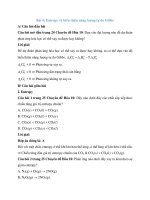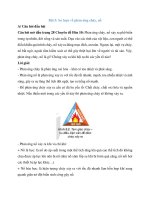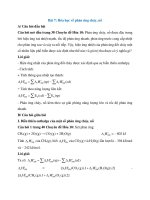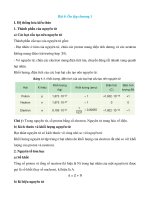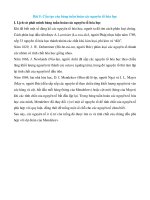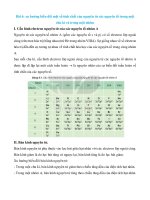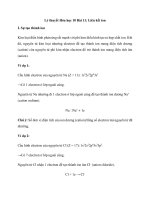Tài liệu tiếng anh văn hóa anh mỹ
Bạn đang xem bản rút gọn của tài liệu. Xem và tải ngay bản đầy đủ của tài liệu tại đây (73.88 KB, 13 trang )
CLIFFS NOTES
FOR
AMERICAN CULTURE AND SOCIETY
CHAPTER 1
INTRODUCTION
1. The United States of America has:
●
●
●
●
●
The Atlantic Ocean in the East, the Pacific Ocean in the __West__,
____Canada___ in the North, and __Mexico__ in the South
__50_ states: __48_ contiguous states, __2_ noncontiguous states
__Hawaii__ and _Alaska_
1 federal district: Washington, District of Columbia_ (the capital)
Several territories and island possessions
_330 million_ people
2. Two significant factors that affect American culture are: (Para 3)
●
●
●
●
●
●
●
●
Its immense __size of the US_
Different _climates_, lifestyle
Its great __ethnic__ __diversity__, including:
Native Americans
Europeans
Hispanic __
Latino Americans_________
Black or African Americans_________
® Cultural _pluralism_
3. A nation of immigrants (Para 7)
__Melting______ pot is the term used to describe American culture because the
dominant American culture has survived and successfully_absorbed vast
numbers________ culture of immigrants throughout its history.
4. The 21st-century immigration pattern (Para 11-12)
●
●
The percentage of _white_ Americans from Europe is growing smaller
More than half of all the new immigrants are from _Latin America_
® _white Americans of European descent_______ communities grow
CHAPTER 2
TRADITIONAL AMERICAN VALUES AND BELIEFS
1. Traditional American values (Para 5)
Six basic values that have become traditional American values:
Dream
Cost
Individual
Freedom
Self-Reliance
Equality of
opportunity
Competition
Material wealth
Hard-work
2. Individual Freedom & Self-reliance (Para 6-7-9)
●
In the Constitution, the early settlers decided on:
®The separation of _Church_ and _State_
®No _aristocractic_ society, no ruling class of noblemen
●
By _limit__ the power of the __government_ and the _churches_, the
early settlers:
®Create a climate of __freedom_ emphasizing on the _individual_
Ø Individual _freedom_ (individualism)
●
As a price, individuals must learn to rely on _themselves_ or risk
_losing_ freedom
®Americans must achieve financial and emotional
_independence__
3. Equality of Opportunity & Competition (Para 13-15-16-18-31)
●
Lack of a _hereditary_ aristocracy (Para 13,15)
®People from low social class can still rise to __ social positions
●
Each individual should have an _equal_ chance for success (Para 31-16)
®Americans see life as a _race_ for success
®“ _fair_ play”
●
As a price, a person must __ with other people (Para 31-18)
®“ __Winner (honored)_” vs “__Losers (dishonored)__”
®The _pressures_ of competition in the life of an American begins in
childhood and continue until retirement from work.
4. Material wealth and hard work
●
Most immigrants come to the US to have a better life and raise their
___standard of living__________. (32-21)
®The American Dream: “From rags to _riches_”
●
●
●
Acquiring and maintaining _a large number of _ _material possessions_
is very important to most Americans. (22-23)
Material wealth is a widely accepted measure of _ _social status_ in the
US.
As a price, Americans must ____godliness_________ (33)
®Material wealth = the natural _reward_ for hard work and evidence of
their _abilities_. (24)
5. The American Dream (34-28-29)
In understanding American culture, it is important to distinguish between
idealism_______ and __reality_____, when keeping in mind how American
ideals still influence almost every facet of life in the US.
CLIFFS NOTES
FOR
AMERICAN CULTURE AND SOCIETY
CHAPTER 3
THE AMERICAN RELIGIOUS HERITAGE
1. Freedom of Religion in the US (Para 1)
●
●
●
Americans believe in _individual__ __freedom_
○ Believe in the _right_ of individuals to practice their own religion.
○ Religious freedom must be protected
Great ethnic diversity
○ _religious_ _pluralism_
The separation of _Church_______ and ___State_____
○
Forbid the US from ever establishing an _official faith,or a national
church________ _______
2. Christianity in the US (Para 3)
●
●
●
The majority of Americans are _Christians_
○ More than half are _Protestant_
The Catholic faith was first brought to North America by the _Spanish_
in the 1500s.
In the 1600s, Protestant European settlers, most from _England________,
began establishing colonies in the east coast.
3. Religious Diversity in the US
●
●
●
Americans believe the _individual_, not the _organized church_, should
be the center of religious life (Para 22)
Encourage a _tolerance_ and acceptance of _all faiths_
Develop religious diversity ® religious diversity is _growing_ (Para 26)
○ The number of _Protestants_ is declining
○ More people strongers__ faiths
○ New religious organization emerge
○ More young Americans are attracted to _Eastern_ religious
teachings.
○ They are looking for a belief system that will help them _grow and
improve_ as individuals, and not interested in participating in a
religion out of _duty_.
CHAPTER 4
THE FRONTIER HERITAGE
1. The impact of the American Frontier (Para 1-3)
●
●
●
●
●
●
●
The frontier has been particularly important in shaping American
_values_______.
The frontier experience began when the first colonists settled on the
__east coast _ in the 1600s.
It ended about __1890_ when the last western lands were settled.
The American frontier consisted of the relatively __unsettled_ regions in
the __west_ of the US.
They came to believe that it was their destiny to control all the land
○ _Manifest_ _Destiny_
Many Americans still see the frontier people and beliefs as inspiring
examples of traditional American values. (Para 5)
○ Hard work
○ _Competitiveness_ and sense of adventure
○ _ Individualism _
○ Self-reliance
○ _Equality of opportunities
Americans tend to view the frontier settler as the model of the _free_
individual, because the frontier settlers had more freedom from
__government_ controls. (Para 7)
CLIFFS NOTES
FOR
AMERICAN CULTURE AND SOCIETY
CHAPTER 5
THE HERITAGE OF ABUNDANCE
1. A history of abundance
●
●
America has been criticized as a “_throw-away_” country, where there is
so much abundance that people are viewed as _wasteful_. (Para 1)
This abundance is the gift of _nature_. When the European settlers
arrived in North America, they found a continent with: (Para 2)
· Rich, fertile farmland_
· Abundance of _trees_and _animals_
· _small_ population
· great _undeveloped_ _natural_ resources
●
This abundance is increased due to equality of opportunity (Para 5)
· in a nation such as the US, wealth and _social position_ were
not determined by birth _______. (Tocqueville)
®American desire to _increase_ their personal _wealth_ and material
_comforts_
®Increase the nation’s material _abundance_ as quickly as possible
®Love of material things was seen as a _virtue_, a positive incentive to
_work hard_ and a _reward_ for successful efforts. (Para 7)
®American people judge themselves and other people by _materialistic
standards_______.
2. From Producers to Consumers (Para 9)
●
●
●
In the 1700s and 1800s, most Americans thought of themselves more as
_producers_, like farmers and __workers____________.
Since the 20th century, Americans began to think of themselves as
_consumers than as producers_.
Mass media, such as radio and _television_, enable _mass_ _advertising_
to reinforce the American’s _self-image_ as a consumer.
3. Effects of Mass Advertising (Para 11-12)
●
●
●
●
__Sponsors_ have some control over the content of TV _programs_.
Advertising techniques are used to _change_ Americans’ attitudes,
behavior, and _beliefs_.
People are persuaded to _consume_ more and more products.
Consumerism is the reason for American huge _economic_ development.
4. What American Consumers like:
●
●
●
●
●
●
●
Comfort (Para 13)
__Cleancliness_
○ Commercials for soap, shampoo, deodorants, mouthwash, etc.
_ Novelty _ (Para 16)
○ Inventing new products and _improving_ old ones
○ Using _credit_ card—“buy now, pay later”
Convenience
Labor-saving devices (Para 17-18)
_Fast-food_ restaurants and _take-out_ services
Convenience food that are packaged_______ ready to cook, or are even
_precooked_
®Products are designed and advertised as such (Para 20)
®Reflect the American busy__ lifestyle
5. An Abundance of Technology (Para 21-22-14)
●
●
Technological revolution
New technologies have increased the _hectic pace_ of life in the US
· Change television viewing _habits_
®From traditional broadcast networks (NBC, CBS, ABC, Fox) and public
TV stations*
®To _cable______ and satellite TV (such as HBO)
· Change the way to get entertainment and _information__
®Personal computers and the Internet
®People no longer depend on major resource_______ for news,
information, and goods for sale.
* Public television has no _advertisements_, and programs are paid for by
_contributions from viewers_____ and government grants.
6. The Decline of American Abundance? (Para 30-31-32-33-34-36)
●
●
●
●
During the US’ first 200 years, Americans were always _optimism______
about their wealth and abundance.
This belief was based on their experiences.
○ greatly _reduced______ the conflict between the rich and poor
○ gave strong _support______ to basic national values like freedom,
self-reliance, equality of opportunity, competition and hard work.
Over the last few decades, Americans realize their material abundance
might have a limit_____.
○ the energy crisis and economic recession
○ the rising_______ cost of all things
○ the declining number of high-paying jobs in factories_______
○ Minority_______ populations are often hit the hardest.
Many Americans must _work harder_________ than their parents did to
have the same standard of living. But even that is not enough.
○ Americans are becoming less _wasteful______ and more
protective of their _environment______.
CLIFFS NOTES
FOR
AMERICAN CULTURE AND SOCIETY
CHAPTER 7
GOVERNMENT AND POLITICS IN THE US
1. A suspicion of strong government (Para 1)
The ideal of the ___free____ individual led to American deep
____suspicion_____ of the government.
Many Americans believe that the bigger and stronger the ____government_____
becomes, the more dangerous it is to their ____individual_____
____freedom_____.
2. The organization of the American Government (Para 3-4-5-7-11-12)
●
●
●
The US ____Constitution_____ is the supreme law of the US. It
established the framework for the American Government.
The provisions of the Constitution are more concerned with keeping the
government from doing ____evil_____ than with _____enabling____ it
to do good.
The national government is divided into THREE ____separate_____
branches, balancing each other through the system of ____checks_____
and ____balances_____.
The legislative branch
(____Congress_____)
The
The judicial
____executive branch
_____ branch
(Federal
(Presidency) ___courts___)
Location The ___Capital______
The ___White
House______
The
_____Supreme_
___ Court
Role
____Enforces
____ the laws
___Interprets___
_ the laws
May
____prevent__
___ a bill
passed by
Congress from
becoming law
- Settle dispute
____Makes_____ the laws
Both houses must
_____agree____ on all
legislation before it goes to the
president
- Determine if a
law is
____Constitutio
n_____
Organiza The
The House of
tion
___Senate__ _Representative
____
s_____
Headed by the Headed by the
___president_ _____Supreme
___
Court____
Includes lower
national court
Election
100
435
__Senators_ _Representative
___
s_____
_2_ Senators divided among
each state
the 50 states by
_Representative
s _____
Every _6_
Every _2_ years
years
Elected
__Indirectly__
_ through the
___electoral
college____
Every _4_
years
No election
Justices are
- appointed by
the President
- approved by
the Senate
The system of checks and balances prevents any branch of the US government
from abusing its power.
3. Bill of Rights (Para 9)
●
●
●
Is part of the __Constitution___
Is designed to protect specific __individual rights__ and freedoms from
government interference.
Eg: freedom of expression, freedom of religious worship, fair criminal
procedure, etc.
4. The Political parties (18-19-20-23-34-37)
Two main
parties
_Democratic_ Party
__Republican__ Party
(the Democrats)
(the Republicans)
Political
view
Government should do _more_
to solve _social problems_
●
●
●
●
Voters
●
●
Members
Government should not
_interfere_ in people’s lives
Make more _regulations_
Spend more on
_economic_ security and
_welfare_ state
_Big_ government
●
poorer and less-privileged
Americans
_ethnic
minorities________ and
other nonwhite
_________
women’s rights groups
●
The _Liberal_ (left_-wing)
●
●
●
Make less regulations
give American
business more
_freedom_
_Small_ government
__is supported by
bussiness_ groups
anti-government
Americans
the _Conservative_ (right_wing)
5. Special Interest Groups (Para 26-30-32-33)
●
●
●
●
●
Are often called “lobbying/pressure_ groups”
Are formed by _American_ with similar __special interest groups_ to
more effectively _influence_ the actions of government.
Eg: the NRA, labor unions, farm groups, ethnic groups, etc.
Government and politics are based on reaching compromises with a large
numbers of groups and pleasing as many as possible.
Interest groups have enormous _effect_ on politicians by voting and
contributing large sums of _money_ to _election_ campaigns. Sometimes
this effect is harmful to the United States.
